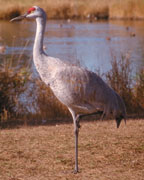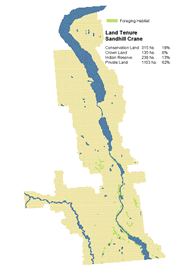|
Habitat Atlas for Wildlife at Risk
Sandhill Crane
Grus canadensis

Sandhill
Crane
|

- Length: 0.9 to 1.2 metres; wingspan:
2 metres.
- Plumage is blue-grey, with a rusty tinge on some
feathers.
- Adults have bare red skin over the forehead and
upper face, and white cheeks.
- Bill and legs are black.
Status:
British Columbia Blue List
Special Significance
This once abundant bird, has declined across North
America due to habitat loss, disturbance and unregulated
hunting. It is not known whether British Columbia's
present breeding population is increasing or decreasing,
but it is clear that breeding populations in the
Southern Interior and in the Fraser Valley were decimated
in the last century. Sandhill Cranes are sensitive
to human activity. Although they pass overhead by
the thousands during fall and spring migration, and
often land and feed during migration, they have not
nested in the South Okanagan since the 1920s. Prevention
of further habitat destruction and human disturbance
are key factors in maintaining British Columbia's
small population.
Distribution
- Most Sandhill Cranes seen in British Columbia are migrating between
nesting grounds in Alaska and wintering grounds
in the southern United States. The Okanagan Valley is one of three
main migratory routes
in British Columbia.
- Spring migration sightings peak in the last half of
April and fall migration peaks in late September
and early October. The cranes usually pass over White Lake, flying
along the west side
of Okanagan Lake before leaving the valley near
Peachland and heading into the Nicola Valley.
- British Columbia breeding populations are scattered
across the province. A handful of pairs have
begun nesting in the Lower Mainland again, but former
nesting grounds on Vancouver Island
and in the Okanagan Valley remain unoccupied.
Habitat
- Sandhill Cranes breed in isolated bogs, marshes, swamps, and meadows.
- Feeding and roosting habitats include shallow wetlands
such as margins of lakes, marshes, bogs, ponds,
meadows, estuaries and intertidal areas, as well as dry uplands
such as grasslands
and agricultural fields.
- Isolation and the presence of water are two important
factors for nesting locations.
- Stopover sites during migration are open areas such
as swampy fields, edge of wetlands, dry rangelands
and grain fields.
Reproduction
- The cranes' elaborate courtship dances begin during spring migration;
breeding pairs stay together for life.
- Nests are a low mound of grasses, sedges, rushes, moss
and branches 1-1.5 metres wide; situated on the
ground or in shallow water surrounded by shrubs or emergent vegetation.
- Two eggs are laid in late April or early May; both
adults incubate the eggs for one month.
- Cranes are active at birth and able to leave the nest
within 24 hours.
- Both parents feed the young until they are about
half grown and able to find their own food;
usually only one offspring survives due to intense sibling aggression.
- Young cranes begin to fly at about 70 days; fledglings
quickly become strong fliers and are able to
begin migration with their parents only days later.
Food Habits
- Diet includes a variety of roots and berries, grasses, lichens,
insects, snails, amphibians, reptiles, small mammals, fish, seeds
and grains.
- Grain fields, farmlands and grasslands are important
feeding areas during migration.
Interesting Facts
- Unborn young produce distinct calls from inside the egg and the
adults respond with a purring sound.
- A crane's vocal repertoire may exceed a dozen kinds
of calls.
- Migration follows the same route, uses the same rest
stops and occurs at the same time each year.
- Cranes are often confused with the Great Blue Heron,
which lacks the red forehead patch. In flight,
the two birds are quite different as well - cranes hold their neck
straight while herons fly
with their head curved against the shoulders.
- Migrating flocks of cranes are sometimes mistaken for
geese, but are distinguished by their loose circling
pattern of flight and their loud "bugling" call which
can be heard kilometres away.
Threats
- Low population growth rates due to late sexual
maturity and small number of young each
year, means a slow recovery rate after disturbances.
- Loss of important crane habitat due to drainage
projects, agricultural development and logging.
- Cranes are sensitive to disturbance; birds may
desert a nest due to intrusive disturbance.
Management Considerations
- Protect key habitats such as wetlands and grasslands.
- Advocate Sandhill Crane research and land acquisition
proposals that will benefit the cranes.
- View these sensitive birds from a distance.
- Contact your local Ministry of Water, Land and
Air Protection office to report sightings
of nests and cranes with young.
|
References
1. Campbell, R.W., N. K. Dawe, I. McTaggart-Cowan, J. Cooper, G.
Kaiser and M.C. McNall. 1990. Birds of British Columbia: Volume 2.
Royal British Columbia Museum, Victoria, BC.
2. Cannings, R.A., R.J. Cannings and S.G. Cannings.
1987. Birds of the Okanagan Valley, British Columbia. Royal British
Columbia Museum, Victoria, BC
|